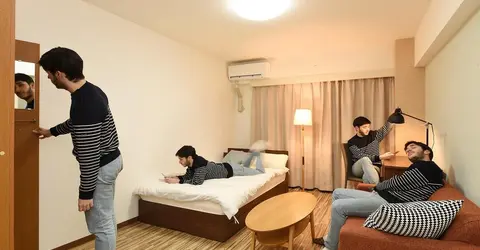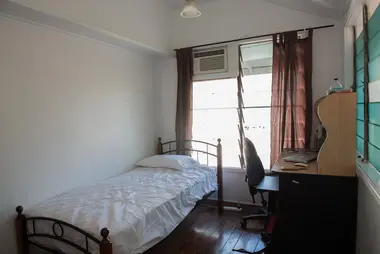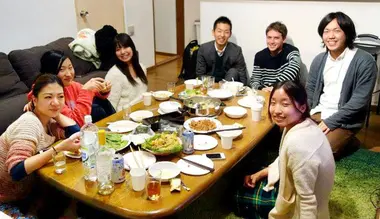The share-house: an economical way to stay in Japan
- Published on : 11/12/2018
- by : Ph.L
- Youtube

Share-houses, an economical way to stay in Japan
Flick/ JAPANKURU.COM
Living in a community in Japan, anyone?
Faced with the prohibitive cost of traditional housing in Japan, especially for foreigners, the share-house is becoming an increasingly popular , economical and practical alternative. Halfway between a traditional shared apartment, a university residence and a youth hostel, this type of housing significantly reduces accommodation costs while offering an enriching community experience. With rates generally fluctuating between 250 and 600 euros a month, and no traditional Japanese entrance fees, the share-house appeals to a varied public ranging from students to foreign workers.
What is a share-house, and how does it differ from a conventional shared apartment?
Share-houses are based on a simple concept: rent a private room and share common areas (kitchen, bathroom, toilet) with other residents. Unlike traditional Western shared accommodation, Japanese share-houses are managed by specialized agencies that handle the administrative and day-to-day running of the house.
This fundamental difference means that residents don't choose their roommates, but integrate an already established structure with precise rules. This is precisely what makes the share-house a unique blend of traditional flatshare, university residence and youth hostel. In Japan, this type of accommodation is particularly popular with foreigners, as it bypasses the usual obstacles of conventional renting: the absence of a Japanese guarantor, rigid contracts and exorbitant entry fees.
The origins of this concept can be traced back to the 90s with the "gaijin houses" (houses for foreigners), created specifically to address the difficulties faced by non-Japanese in the local real estate market. Today, these residences welcome foreigners as well as Japanese, creating a cosmopolitan environment conducive to cultural exchange.
The different types of share-houses and their characteristics
The world of Japanese share-houses is highly diverse, both in terms of size and concept. There are small houses for 4 to 10 people, intimate cottages, as well as large residences for up to 60 residents. Some occupy single-family homes, others floors of apartment blocks, or even entire buildings.
Depending on the share-house you choose, you can opt for :
- Mixed-gender or single-gender residences (many share-houses are exclusively for women)
- Themed houses bringing together people with similar interests (vegetarians, entrepreneurs, artists, etc.)
- Single rooms or dormitories for smaller budgets
- Spaces with or without specific facilities (gym, garden, terrace, etc.)
In small share-houses, sanitary facilities are often limited (a single shower, a single sink), whereas large residences generally havemore extensive and sometimes luxurious facilities. Some even offer gyms, movie theaters or coworking spaces.
There's also a variant called "social residence", which is distinguished by the regular organization ofsocial activities and events to encourage exchanges between residents. Companies like OAK House specialize in this type of community accommodation.
How much does a share-house cost in Japan, and what's included in the price?
One of the main arguments in favor of share-houses is their advantageous price-quality ratio, especially when compared with the classic Japanese rental market. Rates generally range from 30,000 to 90,000 yen a month (around 250 to 600 euros), with significant variations depending on:
- Location (Tokyo residences are generally more expensive)
- Room size and type (single or shared)
- Facilities available (private bathroom, fully-equipped kitchen, etc.)
- Proximity to transport and amenities
What distinguishes share-houses from the traditional rental market is thesystematic inclusion of utilities in the rent: internet, water, gas, electricity and maintenance costs are generally included. What's more, the absence of "key money" (礼金, reikin) or "entry fees", usually equivalent to 2-3 months' rent in a traditional Japanese rental, represents a substantial saving.
Nevertheless, it should be noted that most agencies charge an initial fee (between 10,000 and 50,000 yen) including admission, cleaning or administrative costs. Unlike the deposit, these fees are generally non-refundable. The deposit, on the other hand, is often returned on departure if the room is left in good condition.
In Tokyo, at Sakura House for example, room prices generally range from 10,000 to 90,000 yen per month (77 to 699 euros). The rent includes all utilities, and the "all-inclusive" approach means you can plan your housing budget precisely, with no nasty surprises.
The advantages of living in a share-house: savings, socializing and convenience
Living in a share-house in Japan has many advantages, beyond the purely economic:
Financial advantages: In addition to more affordable rents, the absence of traditional Japanese entrance fees and the inclusion of utilities mean significant savings. What's more, as rooms are generally furnished, you avoid the costly purchase of furniture. Some agencies, such as Tokyo Sharehouse, even offer seasonal promotions with reduced or waived initial fees.
Multicultural richness: These spaces often bring together residents of various nationalities. While the proportion varies from house to house, there is generally a mix of foreigners and Japanese, creating an ideal environment for practicing Japanese and discovering the local culture on a daily basis. Many Japanese choose these homes precisely to improve their language skills.
Simplicity of administration: for foreigners, share-houses eliminate the usual obstacles of the Japanese rental market: no need for a Japanese guarantor, simplified procedures and contracts often available in English. Agencies like Borderless-House are particularly well suited to non-Japanese speakers.
Strategic location: Share-houses are generally well located, close to public transport and shops. They can be found in all major Japanese cities, from the north to the south of the country, providing easy access to essential services.
Flexibility: Unlike traditional Japanese leases, many share-houses offer flexible contract terms, starting from as little as one month. This flexibility is ideal for stays of intermediate or uncertain duration.
Share-house living also offers a valuable social safety net, particularly for newcomers to Japan who can easily obtain advice and support from their more experienced housemates.
Disadvantages and limitations of share-house living
Despite its many advantages, share-house living also presents certain constraints that you should be aware of before committing yourself:
Limited personal space: Rooms are generally small (often between 7 and 15m²), and sharing common spaces implies a lack of privacy that can take its toll in the long run. This forced proximity can prove trying for people who value their solitude.
Imposed cohabitation: Unlike a traditional shared apartment, you don't get to choose your roommates. So you could be sharing your daily life with people whose habits are very different from your own. Conflicts are not uncommon when it comes to cleanliness, noise or the use of common spaces.
Strict rules : Most share-houses impose strict internal rules: restrictions on visitors (sometimes a total ban on receiving people of the opposite sex), timetables to be respected, no parties allowed, obligation to take part in collective chores such as managing the garbage cans. These rules, while necessary for community life, can be perceived as restrictive.
Unsuitability for certain profiles: Share-houses are rarely suitable for families or groups, as rooms are generally not designed to accommodate more than two people. Travelers staying less than a month will also find little interest, as the minimum lease is usually 30 days.
Non-refundable up-front fees: Although lower than in the traditional rental system, registration or admission fees (ranging from 10,000 to 50,000 yen, depending on the agency) are generally not refunded upon departure, representing a lost investment for short stays.
Minimal equipment: Rooms are often sparsely furnished, and you usually have to buy your own bed linen and utensils. This initial investment can represent a considerable cost for a short stay.
Living in a shared house means accepting these compromises and adopting a tolerant attitude to the cultural and personal differences of other residents.
How to find and book a share-house for your stay in Japan
Finding a share-house to suit your needs can be done efficiently by following a few key steps:
Start your search early: Ideally, start your search at least one month before your planned arrival in Japan. Rooms in well-located, affordable share-houses go quickly, especially during back-to-school periods.
Use specialized platforms: Several websites bring together listings of available share-houses. Among the best known are Guest House Bank and Create Guest-House. These platforms allow you to filter your search according to various criteria: location, budget, room type, facilities, etc.
Contact the major agencies directly: The main specialist companies have their own websites, often available in English and sometimes in French. OAK House and Sakura House are among the best-known and offer a wide range of options in major Japanese cities.
Define your priority criteria: To refine your search, first determine your essential requirements:
- Maximum budget
- Location (close to your place of study/work)
- Type of room (single or shared)
- House composition (mixed or single)
- Facilities required
Check availability and visit if possible: If you're already in Japan, don't hesitate to visit the place before making a commitment. Photos can sometimes embellish reality, and a visit allows you to assess the general atmosphere of the house and neighborhood. For those booking from abroad, some agencies offer virtual tours.
Understand the terms of the contract: Before booking, make sure you fully understand the terms of the contract: minimum commitment period, initial fees, early departure conditions, house rules. Don't hesitate to ask for clarification on any unclear point.
Reservations are usually made online, followed by payment of the initial fee and the first month's rent. To move into the share-house, you'll generally need to present your passport and resident card, and sometimes provide an emergency contact in Japan.
Practical tips for living in a Japanese share-house community
To make your share-house experience as pleasant as possible, here are a few essential recommendations:
Scrupulously respect the house rules: Each house has its own rules concerning visitors, noise, use of common areas or waste management. Respecting these rules is fundamental to maintaining a harmonious atmosphere.
Participate in communal chores: Most share-houses set up a rotation schedule for certain tasks, such as taking out the trash. Make sure you fulfill your obligations on time, and let us know if you're going to be absent during your week of service.
Keep shared spaces clean: Even if a cleaning service regularly intervenes in common areas, be sure to systematically clean up after using the kitchen or bathroom. Nothing irritates roommates more than dirty dishes left in the sink!
Adapt to cultural differences: In an international environment, habits and expectations vary considerably. In many Asian countries, for example, personal space is very important, and disturbing your neighbor is considered impolite. So be attentive and respectful of diverse cultural sensitivities.
Communicate openly but politely: In the event of a problem, prefer direct but non-confrontational communication. If the situation persists, don't hesitate to ask the residence manager to mediate.
Make sure you have everything you need on arrival: Most rooms don't provide bed linen or kitchen utensils. Plan to buy these essentials as soon as you move in, or ask the agency about the possibility of renting them.
Participate in community life without imposing: Don't hesitate to join in or suggest group activities, but also respect those who prefer to keep their distance. The balance between sociability and respect for privacy is the key to successful cohabitation.
Be flexible and tolerant: Community life necessarily involves compromise. An open and understanding attitude to the inevitable minor inconveniences will enable you to turn challenges into enriching experiences.
All in all, a share-house is an economical and practical way to discover Japan in a different way. By being well-prepared for its specificities and approaching the experience with an open mind, you'll be able to take full advantage of this immersion in a unique intercultural environment while keeping your budget under control.
Some websites
If the idea of sharing accommodation during your next stay in Japan appeals to you, here are a few sites that might interest you. You can search for a sharehouse by location, train line, budget, and even equipment (TV, private bathroom, etc.).











